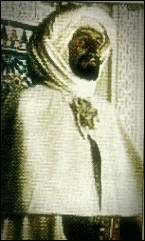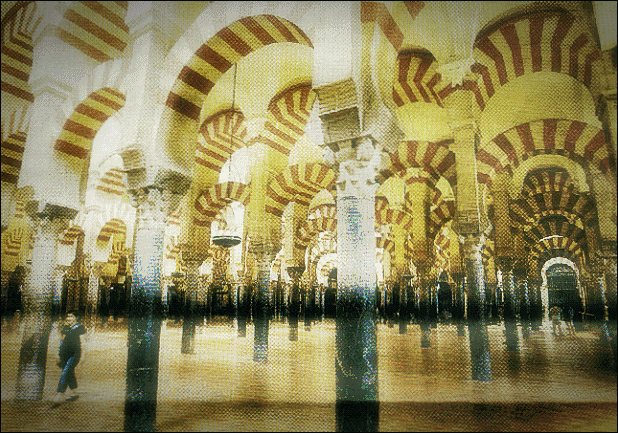Golden age of learning
Dato' Dzulkifli Abd Razak
Article
New Sunday Times - 06/26/2005
A PRINCE of the Umaiyad dynasty, Abd al-Rahman b Mwiyah b (Caliph) Hisham (756-788), was forced to flee Damascus when the Abbasids took control of the Muslim world in 750.
Abd al-Rahman fled to Iberia (modern Spain) and founded a new Umaiyad dynasty there.
Later known as the "Falcon of Spain", Abd al-Rahman was determined to show the world that his capital in Cardoba, where running water and libraries were part of the familiar landscape, was comparable to Baghdad, the capital of the Abbasid Dynasty.
During the Abbasid Dynasty (750-1258), works of Aristotle, Euclid, Galen, Hippocrates, Dioscorides, Ptolemy; Plato, Socrates, Aristotle and other famous men were translated in Baghdad.
|
ABD AL-RAHMAN 111
 |
Over time, copies of these translated works were disseminated throughout the Islamic domains from where they made way into Europe by way of Spain and Sicily in the south of Italy. As such in the first century of Muslim rule in Spain, the culture was largely derived from the flourishing civilization development by the Abbasids in Baghdad. But during the reign of Abd al-Rahman III (912-961), al-Andalus began to assert its own identity and make its own contributions. By 929, Abd al-Rahman in openly challenged the Abbasid Caliph residing in Damascus, by taking on the title Caliph. |
The Cardoban Caliphate was the first urban and commercial economy to flourish in Europe since the disappearance of the Roman Empire.
Abd al-Rahman III was passionately interested in both the religious and the secular sciences, importing books from Baghdad and actively recruiting scholars by offering handsome inducements.
Soon, scholars, poets, philosophers, historians, and musicians began to migrate to al-Andalus.
Before long, the number of libraries, hospitals, research institutions, and centres of Islamic studies increased and it established the intellectual tradition and educational system which was the intellectual hallmark of Andalusian Spain for centuries to come.
Continuous traffic between Cordoba and Baghdad meant that the same reading materials were soon accessible to the Andalusians, who kept up with the latest innovations, fashion, and products.
 MASTERPIECE OF ISLAMIC ARCHITECTURE: The Great Mosque of Cordoba, in Cordoba, was founded in 785. It was added to and expanded over the next 200 years to make it the third largest structure in the Islamic world - Reuters picture
MASTERPIECE OF ISLAMIC ARCHITECTURE: The Great Mosque of Cordoba, in Cordoba, was founded in 785. It was added to and expanded over the next 200 years to make it the third largest structure in the Islamic world - Reuters picture
Eventually, they were capable of exporting their own in return, complementing the Abbasid rule which continued to flourish.
When Charlemagne was crowned Holy Roman Emperor in 800, the Abbasid caliphs were well into the monumental translation project that brought the Greek philosophical and scientific tradition into Arabic.
Under the rule of the fifth caliph (786-808) of the Abbasid empire, Harun al-Rashid, for example, agents were sent to purchase Greek manuscripts from the Byzantine empire where many classical texts were preserved.
Sometimes, they were gifts brought by the Byzantine envoys to Cordoba.
A case in point is a copy of Dioscorides’ treatise on medical botany in Greek, De materia medica, which was presented in 947.
It was translated into Arabic by no less than Hasdai ibn Shaprut, the court physician to Abd al-Rahman III.
Hasdai was instrumental in inaugurating yet another "Golden Age", this time of Spanish Judaism, attracting many Jewish scholars and poets to Cordoba.
Meanwhile in Baghdad, a scientific research institute and translation centre, the-Bayt al-Hikmah or House of Wisdom, was established about 828.
Consequently, the heights of intellectual activity peaked, partly due to a new wave of translators who devoted much of their efforts in translating directly the works of the Greeks.
Gradually, the scientific community began to adjust itself from passive to active acceptance of the Greek learning, giving Andalusia the capacity to create its own intellectual beacon.
The Bayt al-Hikmah, established under Caliph al-Mamun (813-833), included a vast public library, an astronomical observatory, and a bureau of translation.
Greek works, including those of Plato and Aristotle, were translated into Arabic and a world atlas was compiled.
Sciences flourished as original research in medicine was conducted in the Bayt al-Hikmah.
Among the important works translated were the medical texts of Galen and Hippocrates, Euclid's geometry, and Ptolemy's astronomical writings.
Caliph al-Mamun employed people of all races and religions to help translate books from around the world into Arabic.
He held all translators in high esteem, rewarding them in gold based on the weight of their works.
Thus, great libraries and schools thrived on the contribution of the translators, spurring these institutions into becoming great centres of learning.
A leading personality of the "new wave" was Hunayn ibn Ishaq (810-877) who spent time in "the Greek lands", learning the language.
Hunayn abandoned the literal tradition of translation and concentrated on making the sense of the Greek writers comprehensible to Arabic or Syriac readers.
His school translated the entire Alexandrian medical curriculum into Arabic.
He also revised earlier translations of Galen who was renowned for crystallising all the best work of the earlier Greek medical schools.
After Hunayn's death, his son, Ishaq, and nephew, Hubaysh ibn al-Hasan, continued with the tradition.
While Hunayn was bringing new ideas to translate, new movements were stirring in Baghdad.
Mohammed Ibn Musa Al-Khwarazmi, the famous mathematician (d. 863), was combining Greek and Indian mathematics to produce what is now called Algebra (from his book Kitab al-Jabr wa'l- Muqabalah — Book of Restoration and Comparison), at the same time making contribution to geography and astronomy.
By then, there were numerous translations of Greek authors into Arabic in nearly every domain of knowledge.
The ideas and points of views contained in these translations formed a large part of the nutriment which Islam sampled and then assimilated according to its own inner constitution, with the foundation given to it by the Quranic revelation.
As Muslim scholar Seyyed Husseon Nasr said: "In this way there developed, in conjunction with the three basic 'dimensions' of the Law, the Path, and the Truth, Islamic schools which were to become an accepted part of Islamic civilisation."
It was indeed the Golden Age of Learning during the Andalusian Umaiyad dynasty which lasted from 756 to 1031.
Libraries were vastly larger than those in Europe at the time, colleges were established and literature, poetry and architecture flourished.
A new civilisation was born, giving life to religious and ethnic tolerance, interfaith harmony, discovery and free debates which were the norm in facilitating the growth of learning.
